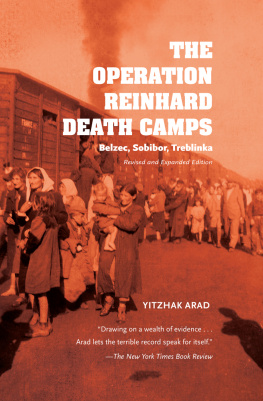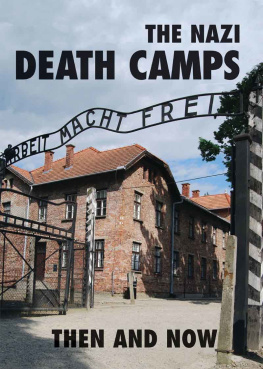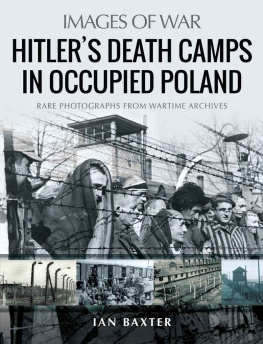This book is a publication of
Indiana University Press
Office of Scholarly Publishing
Herman B Wells Library 350
1320 East 10th Street
Bloomington, Indiana 47405 USA
iupress.indiana.edu
Yad VashemThe World Holocaust Remembrance Center
P.O.B. 3477
Jerusalem 9103401, Israel
1987 by Yitzhak Arad
Updated English version 2018 by Indiana University Press,
Yad VashemThe World Holocaust Remembrance Center, and Yitzhak Arad
All rights reserved
No part of this book may be reproduced or utilized in any form or by any means, electronic or mechanical, including photocopying and recording, or by any information storage and retrieval system, without permission in writing from the publisher. The Association of American University Presses Resolution on Permissions constitutes the only exception to this prohibition.
The paper used in this publication meets the minimum requirements of the American National Standard for Information SciencesPermanence of Paper for Printed Library Materials, ANSI Z39.48-1992.
Manufactured in the United States of America
Library of Congress Cataloging-in-Publication Data
Names: Arad, Yitzhak, author.
Title: The Operation Reinhard death camps : Belzec, Sobibor, Treblinka / Yitzhak Arad.
Description: Revised and expanded edition. | Bloomington, Indiana : Indiana University Press ; Jerusalem : Yad Vashem, [2018] | Includes bibliographical references and index.
Identifiers: LCCN 2018001492 (print) | LCCN 2018017770 (ebook) | ISBN 9780253025791 (e-book) | ISBN 9780253025302 (hardback : alk. paper) | ISBN 9780253025418 (pbk. : alk. paper)
Subjects: LCSH: Operation Reinhard, Poland, 1942-1943. | Concentration camps--Poland. | Holocaust, Jewish (1939-1945) | Belzec (Concentration camp) | Sobibor (Concentration camp) | Treblinka (Concentration camp)
Classification: LCC D805.P7 (ebook) | LCC D805.P7 A728 2018 (print) | DDC 940.53/18538--dc23
LC record available at https://lccn.loc.gov/2018001492
1 2 3 4 5 23 22 21 20 19 18
THIS BOOK IS A STUDY of Operation Reinhardthe name the SS chose for the plan to exterminate the Jews who lived in the General Government of occupied Polandand of three death camps in particular, Belzec, Sobibor, and Treblinka, established with the goal of implementing this plan. Concentration camps and death camps were an integral component of Nazi Germanys governing system and a tool for achieving its political aims. These camps were the responsibility of the SS, headed by Heinrich Himmler. The concentration camps served as places of detention and torture, centers of forced labor, and instruments for the physical elimination of those whom Nazi Germany considered hostile elements, including the Jews. Conversely, the death camps served but one purpose: the physical and total extermination of the Jewish people, regardless of their age or gender; human beings whose only crime was to have been born Jewish, or who were born to at least one Jewish grandparent. The crimes, cruelties, and murders committed by Nazi Germany against the Jews reached their peak in these death camps. Five death camps were erected and operated, all in Nazi-occupied Poland: Auschwitz-Birkenau, Chelmno, Belzec, Sobibor, and Treblinka.
This book describes the process and execution of the deportations from the ghettoes and relates the complete story of three camps in the General GovernmentBelzec, Sobibor, and Treblinkafrom the preparations for their construction at the end of 1941 until their final razing in the fall of 1943. It depicts in full the physical layout of the camps, the transports to the camps, the process of extermination, and the methods and deeds of the SS men who commanded and operated the camps, as well as of the Ukrainian guards, who comprised the majority of the armed forces tasked with guarding the camps.
This book also tells the tale of the hundreds of thousands of people who were brought for exterminationalthough their stay in the camps usually lasted no more than a few hoursfrom the time they disembarked onto the railway platform until their corpses were removed from the gas chambers and buried in mass graves. In each of the camps, a few hundred Jews were removed from the transports and held in the camps to do the physical work involved in the extermination process, as well as some service jobs. Most of these Jews survived for only a short time, from a few days to several months, and were ultimately murdered, as were their brethren who were sent directly from the transports for extermination in the gas chambers. The book describes the daily life and work of these Jews, their underground organization, the revolts, and escapes from the camps. The number of victims in each camp, grouped by location of residence on the eve of deportation, and the timetables for the transports and murder are also included.
The death camps were the final station for the Jews of the General Government. But before reaching this destination, and their ultimate extermination, they were subjected to persecutions, deportations, torture, and murder. This book describes in general terms the German policy toward the Jews of Poland before the implementation of Operation Reinhard, how the decision regarding the operation was taken and its place within the general framework of the Final Solution of the Jewish Question, and the decisions regarding the physical extermination of all of European Jewry. In addition to the Jews of Poland, tens of thousands of Jews from Holland, France, Greece, Yugoslavia, Germany, Czechoslovakia, Austria, and the Soviet Union were murdered in these three camps.
This book is the fruition of extensive research on the camps of Belzec, Sobibor, and Treblinka. The primary sources were testimonies of the few survivors of these camps, German documents, sources of the Polish underground, testimonies by Poles and Germans, and German trial protocols. Nazi criminals who served in these camps stood trial in West Germany. The trial of the SS men who had served in Belzec was held in Munich in January 1965. The primary defendant was Josef Oberhauser; seven other SS men were also tried with him. The trial of the SS men who had served in Sobibor was held in Hagen from September 1965 until December 1966. The primary defendant was Kurt Bolender; eleven other SS men were tried with him. The first Treblinka trial, at which ten of the SS men who served in the camp were brought to trial, among them Kurt Franz, the deputy commander, was held in Dusseldorf between October 1964 and August 1965. The second Treblinka trial, at which Franz Stangl, the commander of the camp, was tried, was also held in Dusseldorf, from September 1969 to December 1970.
The first hardcover English edition of this book appeared in 1987. Since then, new studies have been published on Operation Reinhard and on how the operation was decided on. These studiesincluding the research of German historians Dieter Pohl, Gtz Aly, and Ulrich Herbert; Polish historian Bogdan Musia; American historian Christopher R. Browning; and Israeli historians David Silberklang and Sara Bender, along with many other historiansare reflected in this book.
The research involved in the study of any topic concerning the Holocaust and, above all, the extermination camps is emotionally difficult for any historian, and especially for one who personally experienced those times. My parents, Chaya and Yisroel Moshe Rudnitski, who spent time in the Warsaw ghetto, died in all probability in Treblinka; it is only luck and resourcefulness that staved off the same fate from my sister, Rachel, and myself.













